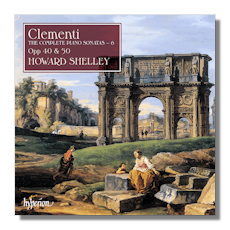
The Internet's Premier Classical Music Source
Related Links
- Clementi Reviews
- Latest Reviews
- More Reviews
-
By Composer
-
Collections
DVD & Blu-ray
Books
Concert Reviews
Articles/Interviews
Software
Audio
Search Amazon
Recommended Links
Site News
 CD Review
CD Review
Muzio Clementi

The Complete Piano Sonatas, Volume 6
- Piano Sonata in G Major, Op. 40 #1
- Piano Sonata in B minor, Op. 40 #2
- Piano Sonata in D Major, Op. 40 #3
- Piano Sonata in A Major, Op. 50 #1
- Piano Sonata in D minor, Op. 50 #2
- Piano Sonata in G minor "Didone abbandonata", Op. 50 #3
Howard Shelley, piano
Hyperion CDA67819 2CDs
This is the sixth and final issue in Howard Shelley's complete survey of the piano music of Muzio Clementi. Clementi, who lived from 1752 to 1832, spanned the years of Mozart and Schubert. His music rarely has the crystalline brilliance of the former, nor the dour melancholy of the latter. Shelley's achievement with this excellent series ought to be to push Clementi into the greater prominence which he deserves. If he does so, it'll be because the pianist has struck exactly the right note in positioning Clementi as a cautious innovator and a composer with a sense of the profound that never runs away with him. The least that could be said about Shelley's approach is that he's made those limitations of Clementi's (perhaps a somewhat restricted, though rarely pedestrian, portfolio of creative techniques, for example) into a virtue: the composer as a purveyor of consistency. And consistently good.
These sound like somewhat backhanded compliments. They're not: in Shelley's expert hands (his own outstanding technique can be taken for granted from first to last) such exact positioning is important. Although at times (even during the first bars of the G Major Op. 40 No 1 [CD.1 tr.1], for example) we could almost be listening to middle period Beethoven, Clementi has something different to say. His manipulation of melody with harmony (the key changes in the middle of that sonata's third movement, for example; and its subtle rubato-heavy rhythmic nuances) are enough to accord Clementi our full attention in his own right. They certainly will do so by the time we get to the presto finale… the sonata's fourth movement.
Later, in the second sonata of the Opus 40 group, the B minor, Clementi's blend of experimentation and sureness of form cannot but impress the listener familiar or not with Clementi's sense of structure. And familiar with the ways in which the instrument can support such structure in the variations on sonata form that were by then (the early years of the nineteenth century) allowed. The third, in D, is even more magisterial. Again, though, for all its melancholy (Clementi was surely at his best when writing in a minor key), Shelley presents this work (and all the others on this two-CD set) emphatically not in such a way that you feel, "Ah, so this is where the series has been leading… Romantic Angst; or Schubertian or Beethovenian introspection; or Schumannesque isolation." Rather he plays each sonata with such precision and insight that it stands in its own right; and is overshadowed by no other composer's light. Although it has to be said that we revel in the way that most of these movements evolve (the gradation from Molto adagio e sostenuto to Allegro con fuoco e con espressione, for example, is spell-binding in Shelley's hands) with as much enjoyment and engagement as we do those contemporary composers' piano music. Indeed, as the second CD, and the last sonata, Opus 50 No 3, draws to a close, a glow of having been able to bed happily down into Clementi's world – as one can perhaps do only otherwise in the piano repertoire of Schumann – has completely taken us over. And not least because of that tonal consistency of Clementi's.
That's an enormous achievement on Shelley's part. Your reaction is to understand why, and endorse the fact that, the pianist undertook the project, a project which has – justifiably – received a great deal of critical praise since the first CD set appeared only two and a half years ago. His playing has an insight and lightness of touch that bring out in the music exactly that balance between transparency (listen to the wistful yet not over-indulgent adagio of the Opus 40, No 3 [CD.1 tr.9], for example) and insistence (as in the allegro non troppo ma con energia of the Opus 50 No 1 [CD.2 tr.4]) which is surely the essence of Clementi's vision.
Although it seems likely that Clementi intended a second book or set of sonatas, Opus 40, after 1802, it did not materialize. His travels intervened. By the time the Opus 50 set was written and published almost 20 years had passed, although they may have been some time in the making. Note that Shelley's survey is not strictly chronological: Opus 46 appears on Volume 5 (CDA67814), for example. The three sonatas from Clementi's Opus 50 – by now 20 minutes and over in length each – make a fitting climax to the series. They are lyrical, confident, stormy (at times), witty; above all they are conceived with a great sense of thematic unity; yet far from obsessive, or "reduced" in any way. It seems from Shelley's playing as if their beauty and power advocate themselves. Yet clearly it does require a pianist to invite us to enter and enjoy the utterly compelling world of this still neglected composer.
The CD is as well-recorded as one expects with Hyperion; the acoustic is plain and responsive. The booklet's notes are shorter than one might expect (and hope) given the significance of this series. There are rival series (by Costantino Mastroprimiano on Brilliant Classics and Susan Alexander-Max on Naxos). But, unless you'd prefer a more authentic instrument than Shelley's modern grand, this is the set to get. Strongly recommended.
Copyright © 2010 by Mark Sealey.





















